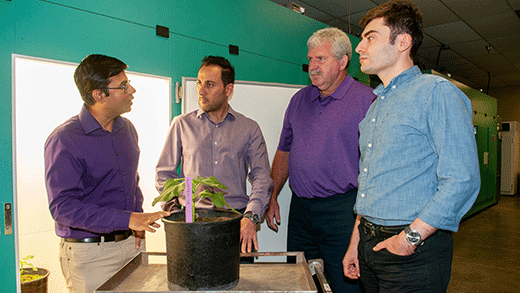
A team of K-State researchers is building a tool to measure sap flow -- or the movement of water -- in plant stems. Pictured, left to right, are Krishna Jagadish, Behzad Ghanbarian, Gerard Kluitenberg and Mohammad Shadmand. | Download this photo.
K-State researchers to track water movement in plant stems
Study could provide new ideas on how to improve efficiency of water use on farm crops
August 1, 2019
MANHATTAN, Kan. – A team of Kansas State University researchers has been given the green light to explore how water moves through plant stems, an idea that could greatly improve the efficiency of its use in growing farm crops.
They have received $300,000 from the National Science Foundation for a two-year project that will build a tool to measure sap flow – or the movement of a liquid through plant stems.
“In this case, we are talking about water,” said Krishna Jagadish, associate professor of agronomy. “In a plant, roots take up water, which then needs to go to the leaves to participate in photosynthesis. The stems are the main road, or the highway. We are measuring the traffic of water on the highway.”
All plants, including farm crops, have different stages of growth, each potentially requiring different amounts of water. The K-State researchers hope to uncover how much water is moving through plant stems during various growth stages, and different times of the day, which should give a clearer picture of how much and when water needs to be provided through irrigation or other means.
“The core idea behind this project is that water matters, no matter if you live in Kansas, Texas, New York or anywhere else,” said K-State hydrogeologist Behzad Ghanbarian. “Given that the world’s population is increasing everywhere, we need to practice agriculture in a way that we make sure we will have water in the following decades for our kids and grandkids.”
Mohammad Shadmand, an assistant professor in electrical engineering, is working with the group to build a tool that utilizes nuclear magnetic resonance (NMR), a concept that comes from physics.
“It’s a non-invasive, physical tool,” Shadmand said. “We will use four magnets surrounding the plant stem to provide an external magnetic field around the stem, which allows us to detect how fast water is moving through it.”
The NMR tool never touches the plant, and would be capable of measuring sap flow in the plant at different times of the day. Past studies have tracked sap flow at a given point by physically cutting or inserting probes into the stem.
“When you go to the gym to work out, you breathe faster,” Ghanbarian said. “Breathing is a dynamic reaction in our body. That’s what happens to plants. They don’t continuously ‘breathe’ or use water at the same rate. In the morning, the amount of water being used, or the flow rate in the stem, would be different than in the afternoon or at night. It’s important for us to understand how much water is being used at different times.”
Jagadish noted that the project is funded through an NSF program known as EAGER (EArly-concept Grants for Exploratory Research). The program is intended to encourage high-risk and high-benefit ideas for transformative research. He said that sap flow has never been measured non-invasively in the United States using nuclear magnetic resonance.
“At this time we really don’t know how it will work,” Jagadish said, adding that the tool could be commercialized if the researchers’ work is successful. “This is a tool to guide us in the direction to help farmers. There may be intermediary people – engineers or modelers or others – who will actually use the tool. In time, we can possibly quantify the amount of water that we are currently allocating and determine if that is efficient or not.”
Gerard Kluitenberg, K-State professor of agronomy in soil and environmental physics, is testing the NMR tool in laboratory settings. The researchers will then conduct field tests with sunflowers, and eventually will include other farm crops.
“We really don’t know how much water plants require for any specific environment,” Jagadish said. “If you put too much, you are wasting water; if you do not irrigate enough, you lose yield. In the long term, this tool will help farmers optimize production practices, or increase crop per drop. To make that into reality, you need tools like this.”

